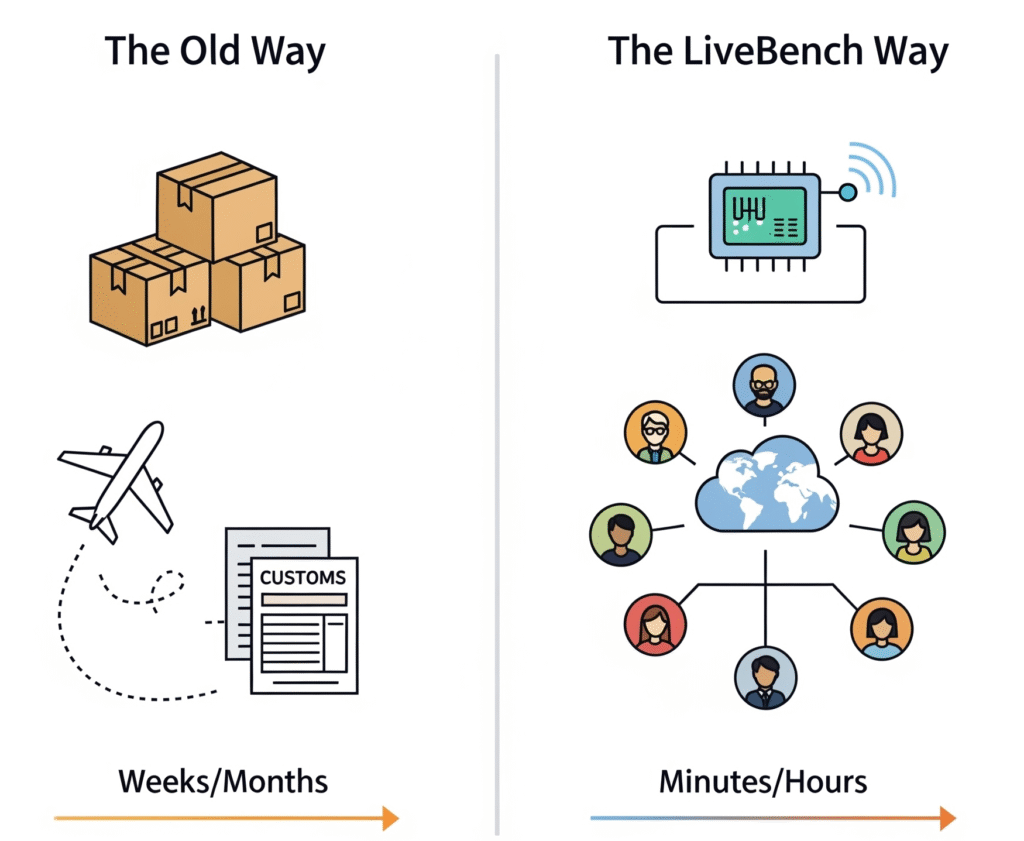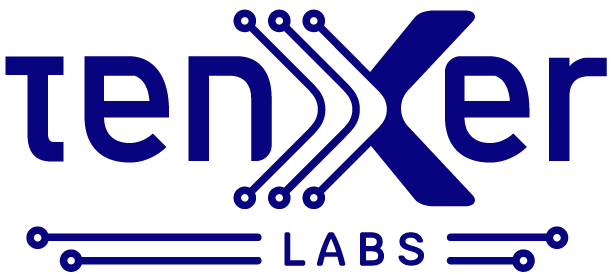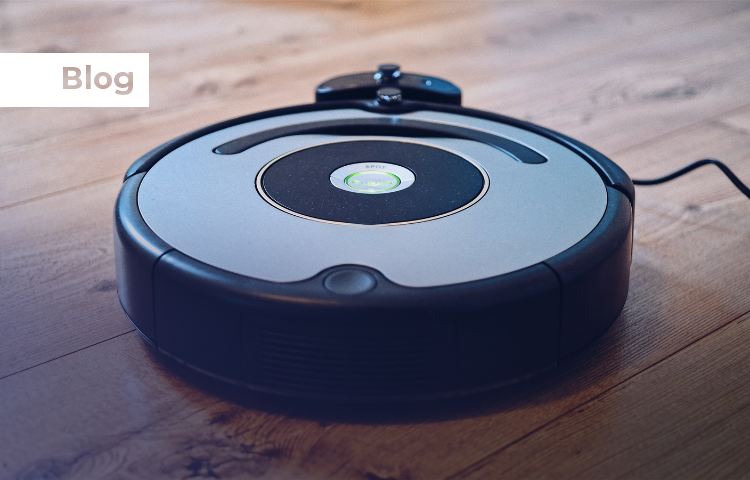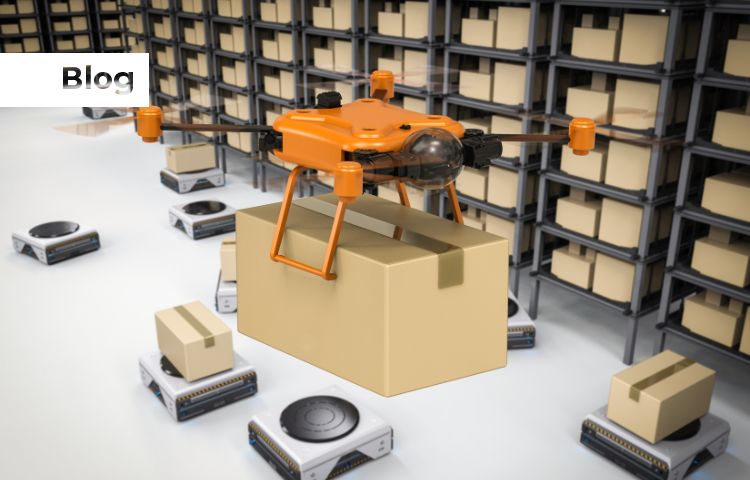An engineer in Germany needs to evaluate your new magnetic sensor for an automotive application. A potential high-volume customer in South Korea wants to test your latest air quality sensor for a smart city project. Traditionally, this meant shipping expensive evaluation kits across the world, navigating customs, and hoping they arrive intact—a process taking weeks. What if they could both access and fully characterize your hardware in minutes, right from their desks?
This blog outlines the possibility for delivering this and tapping the hidden sensor market.Tenxer Labs
Introduction: The Next Wave of Sensor Market Growth
The global sensor market is booming, fueled by advances in IoT, automation, edge AI, and the rising demand for real-time data.
- Global Sensor Market Size and Growth: The global sensor market was valued at approximately USD 241 billion in 2024 and is projected to reach USD 258 billion in 2025, growing at a CAGR of 8.1% through 2032. This expansion is driven by IoT adoption, with the IoT market expected to surge from USD 714 billion in 2024 to USD 4,062 billion by 2032 at a CAGR of 24.3%. These figures underscore the “booming” nature of the market and highlight IoT’s contribution to real-time data demands.
- IoT’s Impact on Sensor Demand: By 2025, the number of connected IoT devices is forecasted to reach 27.1 billion globally, up 13% from 2024, generating over 79 zettabytes of data annually. This proliferation fuels sensor integration in edge AI and automation, but evaluation constraints limit access—remote labs like LiveBench can bridge this by enabling instant, scalable testing.
Yet, for every mature segment like automotive or industrial automation, there are dozens of untapped sensor markets waiting to be explored by innovators and disruptors. The real constraint isn’t always technology – it’s access to rapid, scalable, and cost-effective sensor evaluation capabilities.
Untapped Sensor Markets: What and Where Are They?
The untapped sectors represent ~30-40% of untapped sensor opportunities, with overall sensor market growth at 8.1% CAGR through 2032. Barriers like “high cost of physical demos” (e.g., evaluation kits costing USD 100-500 each, plus shipping delays of 2-4 weeks) are quantified in the next section. Remote labs address this by enabling simultaneous multi-region evaluations, potentially unlocking USD 50-100 billion in niche revenues by 2030.
| Sector | Key Sensor Applications | 2025 Market Size (USD Billion) | Projected CAGR (2025-2030) | Rationale for Untapped Potential |
|---|---|---|---|---|
| 🌾 Smart Agriculture | Soil health (NPK), nutrient levels, microclimate monitoring, pest detection | 2.6 | 11.8% | Precision farming drives demand, but high demo costs limit adoption by small farms; remote labs enable cost-effective global testing. |
| 🌍 Environmental Monitoring | Air quality (PM2.5, CO2, VOCs), water pollution, chemical detection | 25.1 (overall environmental monitoring; sensors ~40% share) | 7.2% | Rising pollution regulations boost need, but niche sensors face integration hurdles; cloud labs accelerate validation for startups. |
| ❤️ Biometric & Health | Non-invasive glucose monitoring, continuous heart rate variability, sweat analysis | 12.2 (healthcare biometrics; sensors core component) | 21.3% | Wearables and remote monitoring surge post-pandemic, yet evaluation delays hinder niche health tech; remote access speeds design-ins. |
| 🏢 Smart Infrastructure | Structural health monitoring, energy usage optimization, predictive maintenance | 542 (smart infrastructure; sensors ~20% share) | 20.0% | Urbanization fuels growth, but high physical kit costs restrict SMEs; centralized remote labs democratize access. |
| 📦 Logistics & Supply Chain | Real-time location tracking, cold chain condition monitoring (temp, humidity, shock) | 10.3 (logistics sensors subset of USD 38.5B SCM market) | 6.2% | E-commerce boom increases tracking needs, but global shipping of kits adds weeks and costs; remote platforms collapse timelines to hours. |
How LiveBench and Remote Labs Unlock Sensor Opportunities
The process is simple and powerful:
- Ship Once, Access Globally: Traditional kit shipping incurs USD 50-200 per unit in costs and 2-4 weeks in delays (including customs); remote labs reduce this to zero shipping, with 24/7 access for global users, cutting qualification time by 70-90%.
- Instant Remote Access: Engineers report 50-80% faster design cycles using remote platforms, as seen in Renesas’ semiconductor validation, where real-time hardware access via cloud labs shortened evaluation from weeks to hours.
- Characterize & Validate: Integrated tools enable live data streaming and reporting, reducing errors by 40% compared to physical kits (which face 10-20% damage/loss rates in transit).
Cloud-based platforms like LiveBench are reshaping sensor market access and go-to-market strategies.
The New Economics of Sensor Evaluation

Industry reports indicate physical kit shipping alone costs semiconductor firms USD 10-20 million annually in delays and losses; remote labs like those used by Si-Time for oscillator testing provide instant access, increasing efficiency by 40-60% and enabling smaller players to target niches previously uneconomical.
| Benefit | Traditional Physical Demos | Remote/Cloud Labs (e.g., LiveBench) | Estimated Savings/Improvement |
|---|---|---|---|
| Costs | Shipping/customs: USD 50-200/kit; lost/damaged kits: 10-20% rate; FAE travel: USD 1,000-5,000/trip | Centralized shipping once; no travel/damage; maintenance ~20% of physical | 70-90% reduction in logistics/FAE expenses (e.g., USD 500K+ annual savings for mid-sized vendors) |
| Sales Cycles | Weeks for kit delivery + testing; sequential evaluations | Simultaneous global access; hours for characterization | 50-80% acceleration (e.g., from 4-6 weeks to 1-2 days) |
| Market Reach | Limited to economical targets (e.g., large firms); uneconomical for startups/universities | Cost-effective for niches; 5-10x more evaluations | Expands to 2-3x more customers, unlocking USD 10-50B in untapped niches by 2030 |
Scaling Success: Industry Examples
Global industry leaders like Allegro Microsystems and Renesas have leveraged remote lab platforms to:
Supercharge Global Evaluation: Providing remote access to real hardware has helped expand design-ins across borders, particularly for specialized sensor types in evolving markets.
Democratize Innovation: LiveBench empowers even small startups or university teams to access the latest sensor technology, unlocking ideas and applications that fuel sector growth.

Accelerating semiconductor validation with a platform that offers real-time hardware evaluation and 24/7 remote access.

Enabling real-time remote testing of Allegro’s power and sensor solutions to speed up design and evaluation cycles.

Providing engineers with instant access to real Si-Time oscillators and clocks for quick and efficient device configuration testing.
Why Now?
With IoT devices reaching 27.1 billion by 2025 (13% YoY growth) and smart city investments hitting USD 800 billion in Asia-Pacific alone, sensor demand is exploding. Remote labs lower barriers, allowing innovators to capture 20-30% more market share in niches like greenhouses and smart cities.
Conclusion: Unleash the Next Generation of Sensor Solutions
By 2030, untapped sensor markets could add USD 100-200 billion in value; platforms like LiveBench turn this potential into reality, with users reporting 60-80% ROI in the first year through faster innovation and expanded reach.
If your organization is looking to unlock new sensor markets, don’t let access and evaluation bottlenecks slow you down. Leverage the power of remote cloud labs and platforms like LiveBench to accelerate innovation, expand your reach, and turn opportunities into reality—no matter where your market lies.
Explore remote sensor evaluation with LiveBench today and be part of the next wave of sensor market growth.





